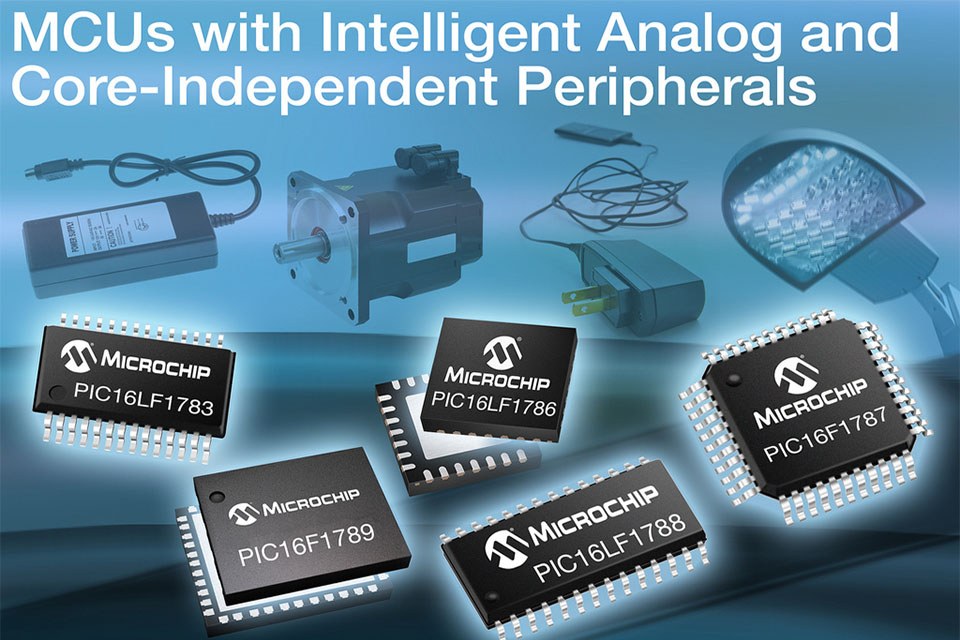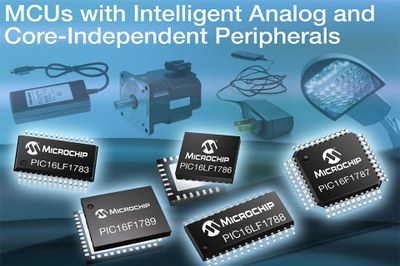Microchip's New 8-bit PIC® Microcontroller Family with Intelligent Analog Integration for SSL Applications
Microchip Technology Inc., a leading provider of microcontroller, mixed-signal, analog and Flash-IP solutions, today announced an expansion of its 8-bit PIC16F178X enhanced Mid-Range core microcontroller (MCU) family with increased Flash memory densities, intelligent analog and digital peripherals, such as on-chip 12-bit Analog-to-Digital Converters (ADCs), 16-bit PWMs, 8-bit and 5-bit Digital-to-Analog Converters (DACs), operational amplifiers, and high-speed comparators with 50 ns response time, along with EUSART (including LIN), I2C™ and SPI interface peripherals.
The PIC16F178X are the first PIC® MCUs to implement the new Programmable Switch Mode Controller (PSMC), which is an advanced 16-bit Pulse-Width Modulator (PWM) with 64 MHz operation and high-performance capabilities. This combination of features enables higher efficiency and performance, along with cost and space reductions. The new MCUs also feature eXtreme Low Power (XLP) Technology for active and sleep currents of just 32 µA/MHz and 50 nA, respectively, helping to extend battery life and reduce standby current consumption. Low power consumption in combination with advanced analog and digital integration make the PIC16F178X MCUs ideal for LED and other lighting applications.
Available in 28- and 40-pin packages, the MCUs’ intelligent analog integration paired with Core Independent Peripherals, inclusive of the PSMC, DACs, Op Amps, high-speed comparators and 12-bit ADC, enable self-sustaining smart control loops with minimal CPU intervention. This allows for optimal application control while freeing the CPU to provide incremental application value, such as system health monitoring, communications, or human- interface control. Additionally, the MCUs feature a 32 MHz internal oscillator, 2 - 16K Words (3.5 - 28K Bytes) of Flash, 256 - 2K Bytes of RAM and 256 Bytes of data EEPROM.
“The PIC16F178X integrates intelligent analog and advanced Core Independent Peripherals, enabling high-performance capabilities within a low cost and versatile 8-bit PIC MCU, lending itself to numerous applications including power supplies, power management, motor control and lighting applications,” said Steve Drehobl, vice president of Microchip’s MCU8 Division. “This level of integration and capability really emphasizes that it is not necessarily all about the core CPU, but rather the capabilities that can be cost effectively enabled.”
Development Support:
Initial evaluation and development of the PIC16F178X family can quickly begin with the F1 PSMC 28-pin Evaluation Board Platform (part # 164130-10, $19.99). Additionally, the PIC16F178X family is supported by Microchip’s standard suite of world-class development tools, including the PICkit™ 3 (part # PG164130, $44.95), MPLAB® REAL ICE™ (part # DV244005), $499.98), MPLAB ICD 3 (part # DV164035, $189.99) debuggers/programmers, and MPLAB XC8 Compiler.
Pricing & Availability:
The PIC16(L)F1782/3/4/6/7/8/9 MCUs are available now for sampling and volume production in 28-pin SOIC, SPDIP, 6 x 6 mm QFN, and 4 x 4 mm UQFN; as well as 40-pin PDIP, TQFP, 8 x 8 mm QFN, and 5 x 5 mm UQFN packages. Pricing starts at $1.18 each, in 10,000-unit quantities.
For additional information, contact any Microchip sales representative or authorized worldwide distributor, or visit Microchip’s Web site at http://www.microchip.com/get/T2VS.
To purchase products mentioned in this press release, go to microchipDIRECT or contact one of Microchip’s authorized distribution partners.
About Microchip Technology:
Microchip Technology Inc. (NASDAQ: MCHP) is a leading provider of microcontroller, mixed-signal, analog and Flash-IP solutions, providing low-risk product development, lower total system cost and faster time to market for thousands of diverse customer applications worldwide. Headquartered in Chandler, Arizona, Microchip offers outstanding technical support along with dependable delivery and quality.
For more information, visit the Microchip website at http://www.microchip.com/get/2VRF.


